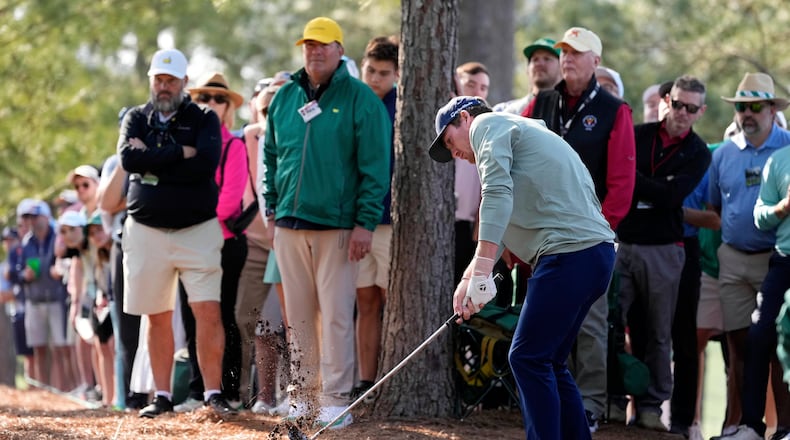AUGUSTA, Ga. (AP) — Nick Dunlap had seen some big numbers start creeping into his game before he arrived at the Masters.
Nothing could have prepared him for the amount of strokes he’d take in 18 holes on Thursday.
The 21-year-old Dunlap dropped five shots over his final three holes of an already nightmarish day to post a round of perfect bogey golf — 18-over 90. That made him the first player in a decade, the third under age 50 and the first under age 38 to fail to break 90 at the Masters.
Dunlap, his eyes bloodshot and his face ashen as he walked from the 18th green to the scoring room to make his ugly score official, did not speak to reporters afterward.
“I’ve played with him a few times this year, and what a great player, what a great guy,” said Robert MacIntyre, whose 75 was the low score in a threesome that also included Billy Horschel (77). “He was struggling out there today, (but) his attitude was solid. He didn’t get in the way. He didn’t lay off anything that was going to affect his two other playing partners because we’ve got a job to do.
“I feel for him today, but he’ll come back.”
Ben Crenshaw was the last player to shoot in the 90s when he opened his final Masters appearance in 2015 with a 91 at age 63.
Most of the players to shoot 90 or worse were aging lions of the game. Masters champions Doug Ford and Horton Smith each did it twice. Charles “Chick” Evans and Fred McLeod accepted midcentury Masters invitations when they were decades past their peak, and each posted two scores beginning with a 9.
Dunlap had an unforgettable entry into professional golf. Last January, he became the first amateur since Phil Mickelson in 1991 to win on the PGA Tour with his triumph at The American Express in the California desert. After some deliberation, he left Alabama to turn professional, and he won again in July at the Barracuda Championship.
This year has been more of a struggle. Dunlap shot 80 in the first round at Bay Hill last month and another 80 in the second round at the Players Championship, part of a run of three straight missed cuts before he arrived at Augusta National.
On Wednesday, he said he was more relaxed than he was last year in his Masters debut.
“Yeah, just able to enjoy it, I’d say a little bit more. I think I was a little bit more stressed out and a little bit more tense last year,” Dunlap said.
The stress returned quickly when he hooked his opening tee shot into the pine straw, leading to bogey.
He dropped his driver after semi-shanking his tee shot on the short par-4 third, pointing to the right dejectedly as he yelled “Fore!”
On the par-4 fifth, another flare to the right forced him to take two shots to escape the trees, leading to double bogey.
After four pars in his next five holes, he found the pond with his approach to the par-4 11th. He didn’t even watch as his tee shot on the par-3 12th missed short and right and rolled back into the water. He found water again on Nos. 13 and 16. Needing bogey on the 18th to break 90, he drove it left, punched it out too far and took four shots to reach the green.
Dunlap wasn’t the only player to post a scorecard littered with big numbers on Thursday. But Nicolai Hojgaard also threw in enough low ones to keep his respectable.
Like Dunlap, Hojgaard had three double bogeys through 12 holes — and only two pars. He also had five birdies in a six-hole stretch on the front nine.
After an eagle on the par-5 15th, the 24-year-old from Denmark had a chance to get back to even, but he closed with three straight bogeys for a 76.
“I was very proud of how I fought back,” said Hojgaard, who’s playing in his second Masters and first alongside his twin brother, Rasmus. “I think that’s something I’ll remember for long time, that you have a bad start and always bounce back.”
Maybe not always, as Dunlap can attest.
But he has a chance at another record. If Dunlap could somehow shoot 68 on Friday, he would set a Masters record for the biggest improvement between the first and second rounds. Craig Wood shot 88-67 in 1963.
___
AP golf: https://apnews.com/hub/golf
Credit: AP
Credit: AP
Credit: AP
Credit: AP
Credit: AP
Credit: AP
Credit: AP
Credit: AP
Keep Reading
The Latest
Featured






